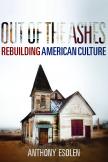Is cultural renewal possible without a culture war?
Teaching seminars on how law intersects with religious values, I have noticed how my students tend toward “fight or flight.” On the one hand, a “lawyer as gladiator” rhetorical model fosters tendencies to caricature an author’s argument so that they can more easily take it down. On the other hand, anxiety about the ultimate social sin—to judge another person’s identity or choices—leads them to merely summarize others’ arguments, thus avoiding putting their own positions and beliefs on the line.
Both extremes distract them from the work of fully understanding the “other side” so as to face the more complex questions at the heart of a conflict or a problem to be solved. What is the antidote? The “sweet spot” is often found by learning how to ask thoughtful questions.
Out of the Ashes, by Dr. Anthony Esolen, is full of “fight.” The publisher’s press release describes the book as a “Battle Plan for Winning the Culture War.” The primary audience seems to be true believers on the traditional and conservative side of the political spectrum. This full-throated battle cry leaves no room for soft apologies or compromise with the enemy. Catastrophic hyberbole is a favorite rhetorical technique, as evident in the take-down of all current approaches to education: “There are only two things wrong with our schools: everything that our children don’t learn there, and everything they do.”
If the book’s intended goal is to be simply a “battle plan,” it could be described as a success. In particular, it is a helpful map to appreciate the connections between the various critical components of this brand of a conservative worldview: family, gender, work schedules; education, leisure and civil society; and convictions about the ideal size and role of government. The analysis is also sprinkled with beautiful passages and images from the classics and other literature that provide much food for thought, even when one does not agree with aspects of the interpretive frame.
But those who are looking for a serious effort to understand, meet or engage center-left or even center-right perspectives will be disappointed. And so the book will probably largely miss the opportunity to engage those who may share Dr. Esolen’s questions about the excesses of progressive ideology, oppressive work schedules and corrosive interactions with technology, even if they disagree with certain aspects of his vision for social change.
According to Dr. Esolen, for example, the breakdown of patriarchy and distinct men-only spaces is a lamentable root cause of the decline of social trust and the disintegration of the family. He argues that “enforced and unnatural equalizing of people is deeply unjust.” “Women sew, but men invent the sewing machine. Or they would—if we encouraged them to be themselves and gave them the space for it, without the distractions of the opposite sex nearby.”
A particularly troubling part of the book is Dr. Esolen’s argument that the encroachment of women into work and public life is to be blamed for a host of evils, including blocking productive civil public discourse. In Congress, the “creative enmity” of days gone by has disappeared because “in the presence of woman [sic], men become more intransigent, not less.” Instead, womanly sympathy “is essentially personal and intimate. It flourishes best at the hearth, the bedside, the table. It is passionate self-giving that makes the home.”
"Out of the Ashes" promises a plan for cultural renewal, but seems to skip the most difficult steps.
The book promises a plan for cultural renewal but seems to skip the most difficult steps—for example, how to address the systemic poverty, often exacerbated by racism, that leads many people to impossibly difficult economic and parenting choices and inhumane work schedules.
In this respect, Dr. Esolen’s scathing critique of the left might also apply to his own blind spots: “The progressive cannot diagnose his own disease. But that does not mean that he rejects the way of the Cross entirely. He makes everyone else walk it.”
Why would anyone who does not align with this “side” of the culture wars be interested in reading this battle plan? Because it could be helpful to spend some time listening to extended arguments—and even passionate ones—outside of one’s own “echo chamber.” Notwithstanding the serious flaws discussed above, it is, for the most part, a well-written, if unfiltered, sustained argument.
My suggestion is to start with the last chapter, “Pilgrims, Returning Home.” In many ways it tracks current discussions of the “small is beautiful” options for cultural renewal, and it gives a mostly positive glimpse of what is at stake for Dr. Esolen, what are his deepest hopes and concerns. By holding that frame steady, I was able to move away from my own combative reactions to other aspects of the book in order to engage his argument with a set of thoughtful questions.
Ashes are not only a mark of prayer, conversion and penance. They can also nourish the soil for plants and living things—not only in the places that we might expect, not only in the ways that we might predict.
This article also appeared in print, under the headline “More hyperbole for the culture wars,” in the May 1, 2017, issue.










